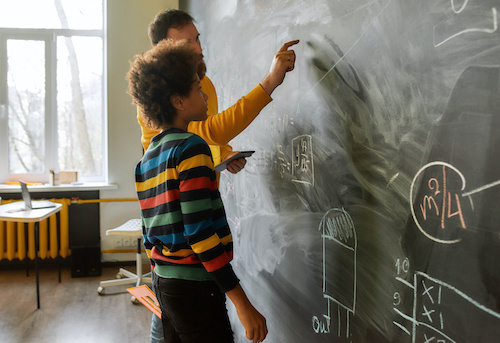Key points:
- Every student can be a math person—we just need the right resources
- Friday 5: STEAM education in action
- How this middle school teacher gets students to challenge themselves in math
- For more news on math learning, visit eSN’s STEM & STEAM hub
Say what you will about the universality of numbers and symbols; I’d politely argue that it does not follow that mathematics is a universal language. The problem for many struggling math students is that often those “universal” numbers and symbols hide in surrounding contexts of unfamiliar vocabulary, settings, and narratives.
As math educators, we can help those students by finding ways to relate their classroom learning to more recognizable cultural frames of reference that are authentic to the range of experiences in the room. In the process, math can actually become a universal thread to connect many types of content and learners. Number sense and quantities are some of the very few things that tie us together in a common experience.
Through my own work in the classroom with students and educators, I’ve discovered a few key ways to change the narrative around math.
Math is joyful!
Math should be an exciting space to be in, one that’s connected to experiences outside of the textbook or classroom. It should be joyful. But for multilingual students like me whose native language is not English, the math classroom can be a daunting place.
I’m a first-generation Dominican American. My mother’s emphasis on speaking Spanish in our home was one of the best things to happen to me—because of her decision, I’m bilingual today. But although I was a stellar student academically, I struggled in math. The linguistic supports I received in other content areas were not as present during math, in large part because of the assumption that math is a universal language.
Despite these experiences, I found my love for math as I became an elementary teacher after earning a master’s degree in education. My years as a classroom teacher and instructional math coach showed me that math not only is fun, and can be found everywhere, but every single person is capable of learning and excelling in the subject.
Through my years in the classroom, I saw many students who reminded me of my early learning self–cautious and or apprehensive of math and their abilities to learn it. While educators provide many scaffolds to help our students learn math, we need to make sure that we integrate content and language into those frameworks. We should teach—and students should learn—them simultaneously.
Every student can be a math person
As a society we’ve considered math a gatekeeper to opportunities. Excel in math and you can pursue a wealth of STEM and other rewarding careers.
Unfortunately, we’ve also conveyed the idea that “some people are not innately math people.” This mindset and belief system could not be further from the truth. In many cases, struggling students simply have not had equitable access to math due to language barriers, underperforming schools, socio-economic issues, or other challenges. But we now have a wealth of resources and proven methodologies to ensure that every student knows and believes from the beginning that they are, in fact, a math person.
Instead of being an opportunity-killing gatekeeper, math can be the bridge builder, a pathway to choice and opportunity, and the thread that connects students to richer learning and life experiences.
Relate math to your students’ cultural frameworks
Educators can start by employing a culturally sustaining pedagogy, tapping into the unique experiences that each learner brings into the classroom. We must invite our students into the learning process as their whole selves, complete with their individuality, differences, and cultural diversity. Then we need to relate the math to each student’s cultural frame of reference, encouraging them to develop (and sustain) their own cultural and mathematical identities while seeing themselves as capable learners.
Utilizing digital learning tools to help improve and support meaningful student participation in math discussions is a key way to bridge this gap. Incorporating translanguaging during class can also encourage students to use their full linguistic repertoire to navigate the content. Language is complex, and we know that navigating it doesn’t always adhere to the silos of one or two. Students may know more or need more help than they’re able to express in any single language.
Math connects content and learners
All students benefit from storytelling and other integrating techniques; relevant and thought-provoking conversations elevate student voices and engage learners. Using storytelling during math instruction can:
- Provide context and make numbers on a page come to life. Math isn’t just 2 + 2 = 4. It’s two baskets for a four-point lead at halftime.
- Bridge mathematical learning to a world beyond the classroom. Teachers can help students see how math animates science, history, music, social studies, art, and sports.
- Restore, affirm, and sustain positive mathematical identities.
In teaching math, we also can’t lose sight of early numeracy. We need to be aware of unfinished learning–not every student comes into class at grade level; taking the time to learn about the whole child and their unique points of view will go a long way in nurturing their joy for learning and, in particular, mathematics.
- 4 ways to encourage play in education - April 25, 2024
- CoSN IT Leader Spotlight: Lisa Higgins - April 25, 2024
- It’s time to pay student teachers - April 25, 2024

